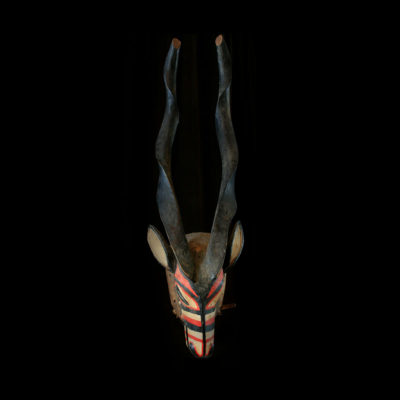
| SKU | PF.1267 |
|---|---|
| Circa | 20th Century AD |
| Dimensions | 40″ (101.6cm) high x 11.125″ (28.3cm) wide |
| Medium | Wood |
| Origin | Mali |
| Gallery Location | USA |
This powerfully-carved antelope mask was made by the Bambara (or Bamana) people of Mali. It is an exceptional example, depicting a male Greater Kudu with massive, imposing horns and pricked ears. The face is striped with black and white pigment, the horns – which have a barley-twist pattern – in black, and the ears and the apex of the head in a wood/red/brown colour. The very tips of the horns have been damaged during usage. This is a very naturalistic representation when compared to most Bambara/Bamana antelope pieces, such as the famous Chi-Wara headdresses that are traditionally worn by secret society members in dances to encourage good crop yields.
The group is one of the largest in Mali (about 2.5 million) and lives in a savannah grassland area that contrasts strongly with the Dogon heartland. Their linguistic heritage indicates that they are part of the Mande group, although their origins go back perhaps as far as 1500 BC in the present-day Sahara (i.e. Tichitt). They gave rise to the Bozo, who founded Djenne in c.250 BC, in an area subsequently overrun by the Soninke Mande (<1100 AD). Their last empire – the Mande-speaking Songhai – dissolved in the 1600s, and many Mande speakers spread out along the Nigeria River Basin. The Bamana empire arose from these remnant populations in around 1740. The height of its imperial strength was reached in the 1780s under the rule of N’golo Diarra, who expanded their territory considerably. However, their influence waned in the 19th century and the empire fell to the French in 1892. Their society is Mande-like overall, with patrilineal descent and a nobility/vassal caste system that is further divided into numerous subvariants of the Bamana state, including the Jula (traders), Fula (cattle herding), Bozo (essentially endentured slaves, carrying out menial jobs) and Maraka (rich merchant class). Unusual jobs are rewarded with caste status, notably historians (Griot), while those whose ancestors were originally slaves to the Bamana (Jongo) have inherited their antecedents’ low status. Age, sex and occupation groups are classed by “ton” – societies that reflect their social importance (age- or sex-related) or work (i.e. hunters, farmers). Given this complex history, it is perhaps little surprise to find it echoed in the systematics of indigenous art traditions. As a general rule, the pieces are highly stylised and betray extensive usage through encrusted patinas and extensive use wear. There are four mask forms, related to the n’tomo society (bearing a large “comb” over the face, related to the initiation of males), the Komo society (horned zoomorphic designs, perhaps related to hunting), the Nama society (aviform designs) and Kore designs, which feature animal heads. Other forms – including the famous Chi-Wara headcrest – are also known, but except for the latter (used for encouraging good harvests), their function is not known. The Guan society is responsible for the maintenance and use of most sculptural forms, notably the Guandousou “queen” and the knife-bearing “Guantigui” statues. They are usually exceptionally refined and tranquil pieces, contrasting strongly with the rather more dynamic but less linear “Dyonyeni” forms, made by the Dyo or Kwore societies, usually representing hermaphrodites with large, conical breasts. Heavily encrusted “Boli” figures are also known, representing animals, but cloaked in a thick coating of mud, blood, alcoholic beverages and kola nuts. Everyday items include iron staffs, wooden puppets and equestrian figures, which double as accessories for male initiation ceremonies. Their anthropomorphic door locks are especially well-known, and are given to women as wedding presents as they imply fertility with a vertical female body and the “male” bar which slides back and forth. This piece would have been worn for a masquerade performance associated with ceremonial celebrations among the Bamana/Bambara. It is an elegant and sophisticated piece of African art and a worthy addition to any collection or domestic setting.
Login to view price
Sign-up to receive the latest Wedding Estates news and promotions!

